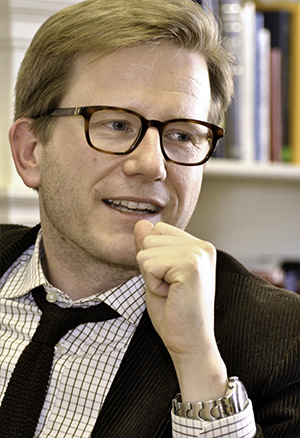
Helge Dedek arrived at the Faculty of Law as a Boulton post-doctoral fellow in 2006, having obtained an LL.M. from Harvard and a Ph.D. from the University of Bonn in Germany. A scholar who examines the law from a comparative and historical perspective and who recently received a grant to spend the coming academic year at the Advanced Studies Institute for Law and Humanities Research, Dedek spoke to Focus online about where history, philosophy and law intersect.
By Victoria Leenders-Cheng
You started teaching a course on Roman law this fall: how did you help students connect to a legal tradition developed two millenia ago?
My specific focus in this course was the idea that we are part of a long-standing tradition that has a certain discursive continuity from 2000 years ago up to today.Of course, the environment of this discourse – the societal, political, ideological context – has been constantly changing. The tension between these two forces of continuity and change – tradition and revolution, if you will – is what fascinates me most.
Take, for example, the Roman institution of slavery. It was one of the corner stones of Rome’s economic and social organization. Slaves were the most valuable movable “things” in a Roman household – we could maybe compare their role to the role cars play nowadays. Roman private law therefore developed many ideas around the sale and ownership of slaves. Today, we understand that slavery is an abomination; and yet we use, unwittingly, concepts in Quebec sales law that were developed in the context of the sale of human beings. This is what I mean by “invisible continuity”. This is a harmless example of how Roman law concepts can be “de-contextualized” and still function in a modern setting. But the same rules were applied in antebellum Louisiana and helped to uphold an actual system of slavery – in the nineteenth century! On the other hand, there are Roman jurists who already argue that slavery is contrary to nature and that every human being is born free. It is this complexity that makes legal history so interesting.
What is it like to work in an area that spans law, history, classics, sociology and philosophy?
Legal history as social or intellectual history is always interdisciplinary. I find it very illuminating to talk to people in other disciplines to see what we all can bring to these discussions. It is often humbling to experience the erudition of the experts in their various fields. However, all of these disciplines have a blind spot. Only if you work together, if you take pictures from different perspectives and put them together you get the full panorama view.

Can you give an example of how a panorama of this kind is created?
Historians usually specialize in a certain period. If they consult a legal document, they will see it as a source that tells them about life in this particular period, and they will ask how this source fits the political or social context of this particular period. You could say that this is a “horizontal” contextualization of law.
If you are interested in legal discourse as an intellectual tradition, you are interested in tracing the development of ideas through time – a “vertical” contextualization, if you will. Almost every legal development in Continental Europe until the nineteenth century has to be seen against the backdrop of Roman law.
What’s interesting then is the intersection between the vertical and the horizontal. To fully understand a certain legal development, you have to understand its place within the tradition, its intellectual pedigree, if you will; and the particular historical context, the political, ideological circumstances at the time. Only if you combine both perspectives will you get the full view.
Is being attuned to different perspectives a motif that comes up in your classes as well?
Yes. I think what I am trying to get across in a class like Roman law is that just by being lawyers (or jurists), we’re not only studying this age-old discourse as observers, but we’re also part of it. It’s quite eye-opening for the students to look at a text that is 2,000 years old and realize that the Roman author is concerned with very similar problems and even invokes similar arguments.
In that way, I believe, a legal history course can teach students a lot about how complex and multi-layered a phenomenon law really is.
This is an edited and condensed version of the original interview. Photos: Lysanne Larose.
